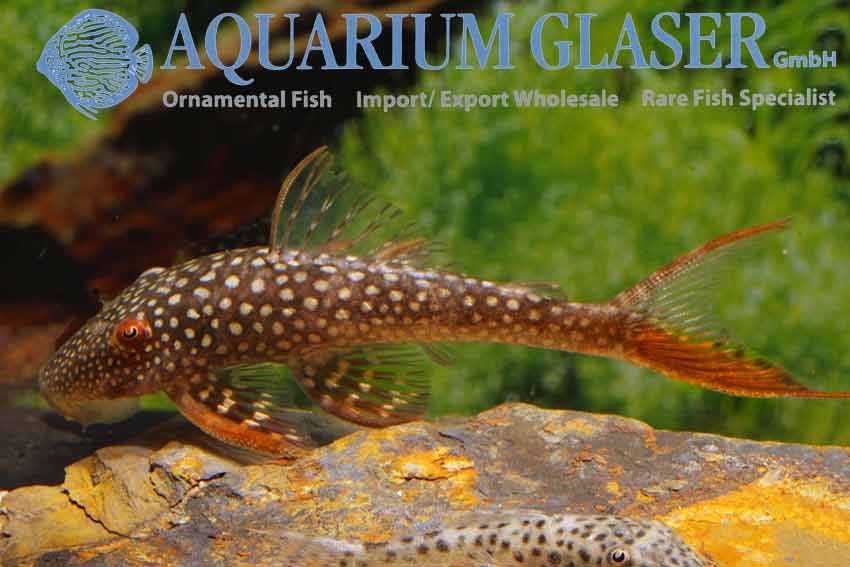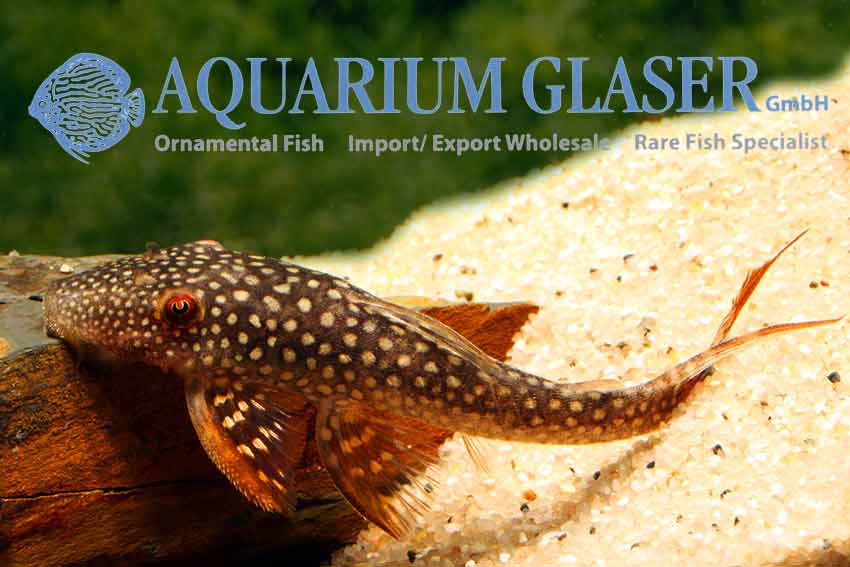
A group of scientifically still undescribed species of Corydoras from Peru has bright metallic stripes over the back and is thus called “Neon Stripe”. Some of these beautiful fish are currently in our stock. One of them is the “Neon Green” (CW9), which we can offer in small numbers as wild caught, another one is the “Neon Gold Stripe” or CW10, which is offered both wild collected and bred. The albinotic CW10 is, however, only available as bred. And the “Neon Red Stripe” (CW14/23, both are same species, the duplication came because one group were kept over a black substrate), sometimes offered bred, rarely wild collected, is probably a local variety of CW10.
The collage shows you all these “Neon Stripes” to give you an overview and help you through the sometimes confusing similar names.
All these Corydoras look a bit like the common Bronze Corydoras and thus are sometimes labelled “Corydoras aeneus” plus additional name; however, the “Neon Stripes” are no close relatives of C. aeneus.
Keeping and breeding of all these beautiful fish is quite easy and can be practiced even by beginners in the hobby. It is only due to the comparatively low reproduction rate that these fish are still among the more expensive species of the genus.
For our customers: Neon Green Stripe Wild (CW9) has code 221055, Neon Gold Stripe Wild (CW 10) code 221073, Neon Gold Stripe Bred (CW 10) code 221062, Neon Red Stripe Wild (CW14/23) code 221033 and Neon Gold Stripe Albino (CW 10) code 221092 on our stocklist. Please note that we exclusively supply the wholesale trade.
| Angaben zum Tier | |
|---|---|
| Herkunft | Peru |



















 For the first time ever we managed to import this breathtaking species of tetra from Venezuela. The about 4 cm long fish always swim in closely aggregated schools. They settled in our fishhouse without problems, but for the photographer these fish are a real challenge. The brilliant glittering colours – blue, green, violet – vanished completely under the flashlight or the fish looked silvery all over the body. Only after a lot of trials we managed to find a position for the flash that allowed to illustrate this fish as beautiful as it looks to the eye of the observer.
For the first time ever we managed to import this breathtaking species of tetra from Venezuela. The about 4 cm long fish always swim in closely aggregated schools. They settled in our fishhouse without problems, but for the photographer these fish are a real challenge. The brilliant glittering colours – blue, green, violet – vanished completely under the flashlight or the fish looked silvery all over the body. Only after a lot of trials we managed to find a position for the flash that allowed to illustrate this fish as beautiful as it looks to the eye of the observer.








































































































































































 It does not happen very often that we feel unable to determine an imported species at least roughly. But when a few weeks ago a shipment containing very small (about 1 cm) Rasboras from Thailand arrived we could name the fish only provisionally “Rasbora sp. Dwarf”. In the meantime the fish have grown happily and now we can say the importation brought a species in our fishhouse we have never been able to import before: Rasbora paucisqualis. This charming species attains a maximum length of 3-4 cm.
It does not happen very often that we feel unable to determine an imported species at least roughly. But when a few weeks ago a shipment containing very small (about 1 cm) Rasboras from Thailand arrived we could name the fish only provisionally “Rasbora sp. Dwarf”. In the meantime the fish have grown happily and now we can say the importation brought a species in our fishhouse we have never been able to import before: Rasbora paucisqualis. This charming species attains a maximum length of 3-4 cm.








 Two days ago we were able to import a single specimen of pike cichlid , which we have never seen before. The animal for sure belongs to the rambling relationship of Crenicichla saxatilis; however, no scientific description on a species exist that has red instead of black markings on the body. Our specimen – most probably a male – is currently about 15 cm long. We believe that is has been collected near the city of Puerto Inirida in Venezuela. This species is illustrated and described in the German book “Die Buntbarsche Amerikas Bd. 3” by Rainer Stawikowski and Uwe Werner as Crenichla sp. Inirida III.
Two days ago we were able to import a single specimen of pike cichlid , which we have never seen before. The animal for sure belongs to the rambling relationship of Crenicichla saxatilis; however, no scientific description on a species exist that has red instead of black markings on the body. Our specimen – most probably a male – is currently about 15 cm long. We believe that is has been collected near the city of Puerto Inirida in Venezuela. This species is illustrated and described in the German book “Die Buntbarsche Amerikas Bd. 3” by Rainer Stawikowski and Uwe Werner as Crenichla sp. Inirida III.

























































































 Code: 278934
Code: 278934